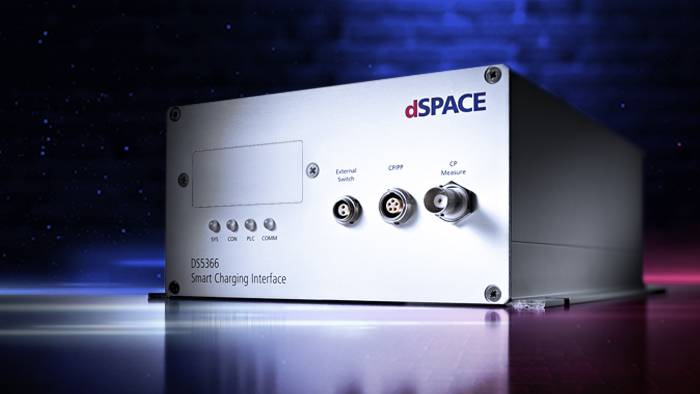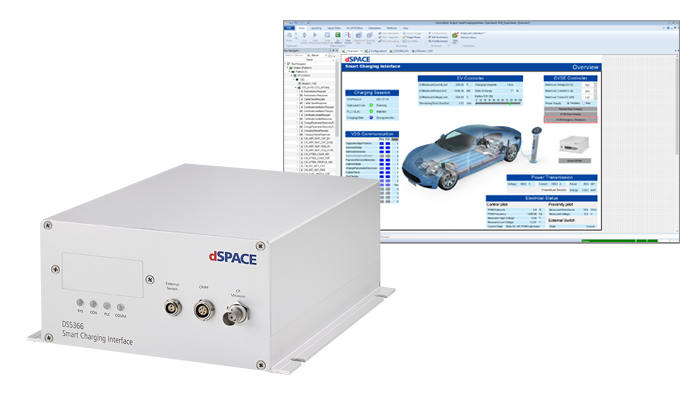A key success factor for electromobility is being able to charge batteries quickly and safely. The range of solutions designed by dSPACE helps optimize the vehicles and charging stations.
Generally, a 21st-century electric car is expected to offer the same amenities as those found in vehicles powered by a combustion engine. In addition to the driving experience, charging the high-voltage battery is an essential point for the driver of an electric car. However, the necessary power supply is still limited in many places due to the lack of a charging infrastructure.
Charging vs. Refueling: A Dynamic Competition
To compare the refueling of a gasoline-powered car to the charging of an electric car, take a closer look at the flow of energy: At an average gasoline pump, a delivery rate of 35 l/min can be expected. Due to gasoline’s high energy density, this corresponds to an electrical output of approx. 20 MW. Even if a gasoline engine is relatively inefficient, with the efficiency rating normally falling below 30%, this still results in a comparable charge rate of 6,000 kW. Thus, it should come as no surprise that charging an electric vehicle can take a good 40 times longer, even at a fast-charging station (e.g., with a charge rate of 150 kW). This means: While gasoline delivers values of roughly 13 seconds per 100 km, the aforementioned charging station would need approx. 8 minutes for the same distance.
Facts:
Refueling: approx. 13 seconds per 100 km
Charging: approx. 8 minutes per 100 km
Alternating Current and Direct Current at Your Fingertips
Because it is possible to simply tap into the alternating current (AC) power grid in both the private and public sector, electric vehicles are always outfitted with an AC charging port by de- fault. However, vehicle batteries require direct current (DC) tuned to their specific state of charge, which is why an inverter is needed. In order to ensure that the inverter is designed optimally for the vehicle battery, this inverter is installed directly in the vehicle. That is where the name onboard charger (OBC) comes from. In Germany, home power outlets are generally designed with a 16-amp fuse. Together with the supply voltage of 230 V, this results in a maximum output power of less than 4 kW. Some houses have three-phase plugs, but these are usually outfitted with a 16-amp fuse as well. In this case, the output power is 11 kW. Most OBCs today are limited to this value since larger OBCs would take up too much installation space, generate more waste heat, and needlessly increase the weight of the vehicle. Most home wallboxes are de- signed precisely for 11 kW. Special charging stations, such as those found at highway charging parks, operate directly with direct current. Since alternating current is converted to direct current outside the vehicle in this case, they can deliver significantly higher charge rates of up to 350 kW.
The Voltage Is Rising
From physics, we know that electric power is the product of voltage times current (P = V * I). At the moment, the voltage levels for most electric vehicles are around 400 V. The classic Combined Charging System (CCS) connector is designed for a maximum current of 200 A, meaning it can provide power at up to 80 kW. The cables and connectors must be water-cooled to provide 150 kW of power as otherwise they would overheat due to the high currents. If you were to double the voltage to 800 V, then the high power would also be available with standard connectors and cables. In order to catch up with the charge rates of fossil fuels, it is necessary to break into the megawatt range. Suitable connector systems are already being tested. This power range will probably first be available in the transport sector.
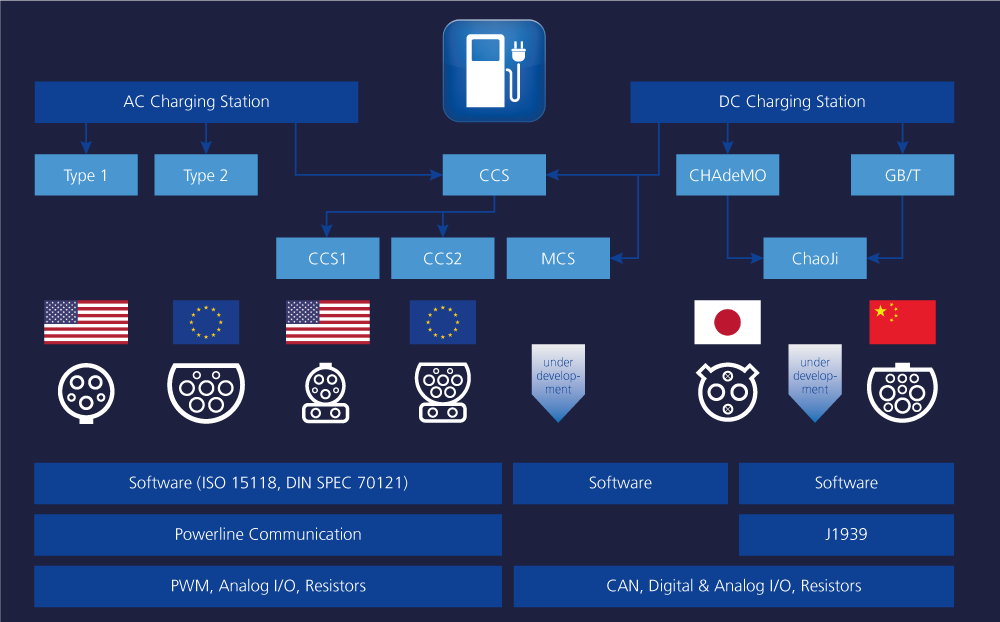
The various communication standards (CHAdeMO, GB/T, CCS) feature completely different connector systems, transmission methods,
and transmission protocols.
Ensuring Safety by Means of Communication
At the charging stations, the vehicle’s high-power components come into contact with the charging infrastructure. It is critical that this takes place under optimal conditions to ensure safe charging. Due to the different international standards and provider-specific systems in place, the vehicles and charging stations have to negotiate and monitor the optimal conditions themselves. This requires bidirectional communication via special wires and plug connectors in the charging plug. This is mandatory for DC charging and increasingly important for AC charging. For AC charging, this holds true especially when connecting to smart home systems and supplying potential consumers within a household. In addition, as the share of electric vehicles rises, it will be necessary to coordinate with the network provider to ensure that the power grid remains stable.
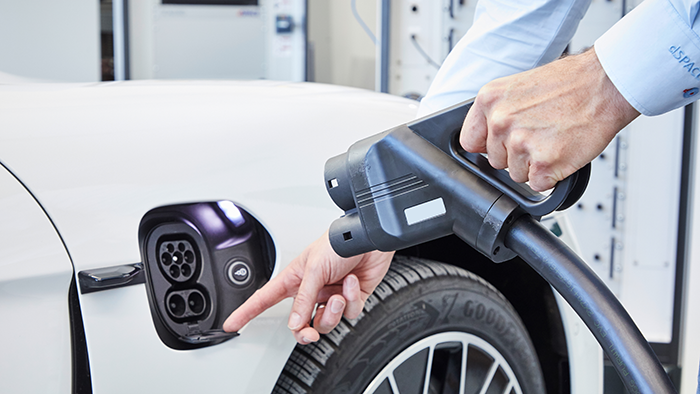
International Charging Standards
Around the world, there are currently three different communication standards (CHAdeMO, GB/T, CCS) that were developed in different regions: one for the USA and Europe and one each for China and Japan. Manufacturers developing vehicles for these different markets have to take into account the relevant standards and test accordingly.
Communication Methods
In Asia, they rely on a well-known medium that is tried and tested in the automotive sector: CAN communication. The CAN bus has been an established vehicle component for decades. In China, the familiar SAE J1939 protocol is also used in the commercial vehicle sector, making it possible to transfer large data packets via CAN as well. The USA and Europe are forging ahead with the Combined Charging System (CCS) and have selected a two-tier communication architecture:
- Basic communication by means of pulse width modulation (PWM) based on the duty cycle and voltage level with a frequency of 1 kHz
- High-level communication in the form of powerline communication (PLC) modulated on the PWM signal on the basis of the HomePlug Green physical layer (PHY) specification, which was developed as part of an alliance between the supply industry and automobile manufacturers. A data link allows for TCP/IP communication between the vehicle and the charging station.
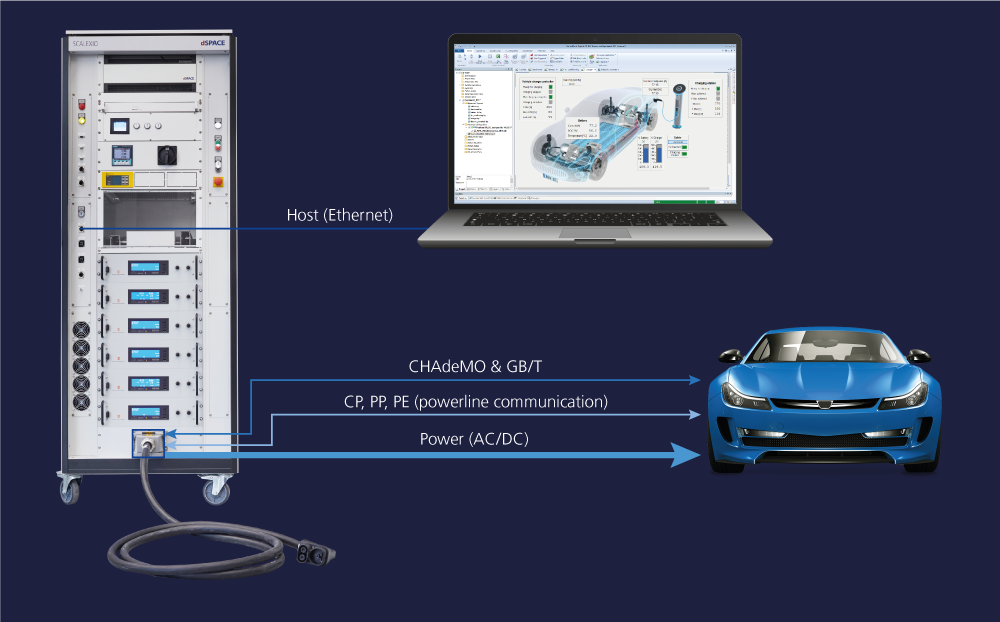
The Smart Charging Station Emulator simulates freely configurable charging stations in full and supports charging processes with up to 1,000 V.
Challenges Posed by CCS Charging
Because the communication wires are housed in the same cable as the power supply and direct current is not always completely uniform, it is essential for the communication to be immune to interference. That is why there are such high requirements for the signal quality of the PLC. It is precisely this PLC that presents new challenges for both vehicle manufacturers and charging station developers in terms of hard-ware and software. Of course, there are also standards that stipulate quite clearly which parameters must be ob- served – unfortunately, there is a high probability that the implementation would not be compatible between the vehicle and the charging station. Such errors can be divided into electrical errors and protocol-errors related to the following aspects:
- Electrical: Voltage level, frequencies, slew rates, attenuation, termination resistors, and electromagnetic compatibility
- Protocol: Reaction time to messages, encoding data in the message telegram, parameterization, using optional parameters, protocol versions, etc.
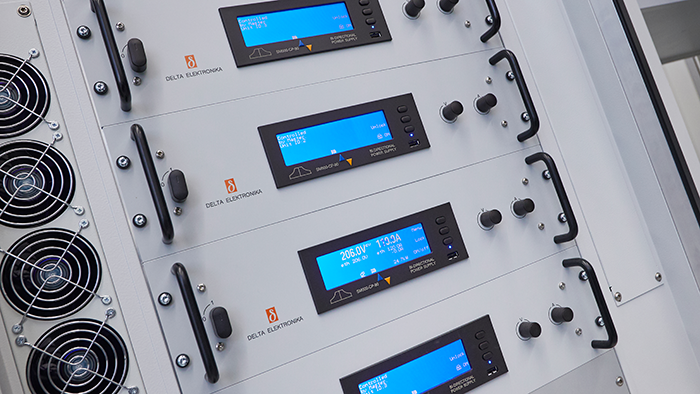
Charging Only in Case of Compatibility
While charging, electric vehicles and the charging infrastructure are tuned to one another, with both taking into account the constraints of the other: a process referred to as smart charging. If there is any sort of incompatibility, the vehicle generally cannot be charged as a result. This is certainly very frustrating for the driver of the electric vehicle and should be avoided at all costs.
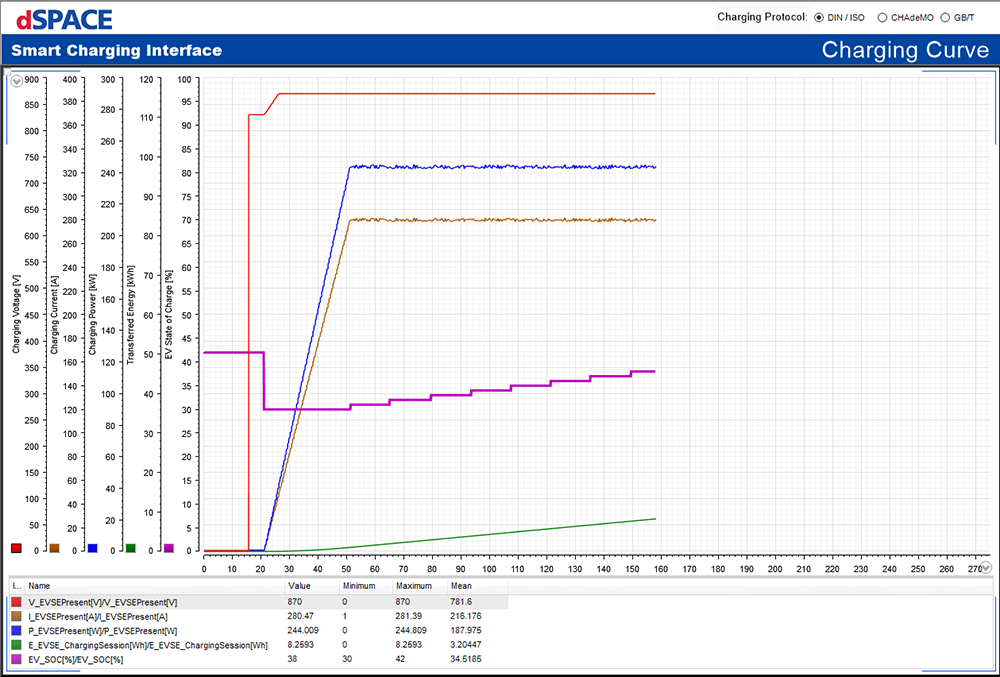
The charging process can be monitored closely with the Smart Charging Solution, together with the voltage, current, and state of charge.
The Range of Smart Charging Solutions at dSPACE
Suppliers and car manufacturers around the world are already using dSPACE systems to develop and test their control applications. These systems often serve as a basis for development and testing in the electromobility sector. The Smart Charging Solution add-on can be used to fully represent the key aspects of the charging process. It offers the following features:
- Easy to integrate into existing test environments
- Comprehensive test options for all relevant standards at the communication and power level
- Easy to automate and parameterize the system
- High transparency for workflows and test library options (white-box testing)
Application Areas of the Smart Charging Solution
Thanks to its great flexibility, the Smart Charging Solution can be used in a wide range of applications, including the simulation of charging stations and the simulation, testing, and development of onboard charging devices. As a result, it supports both electric vehicle manufacturers and charging station manufacturers in developing and testing smart charging technology. It allows for the complete configuration of all timing elements, message contents, and attenuation properties for the transmission. If the communication tests are energized, then the manipulation of voltage and current is added to the equation.
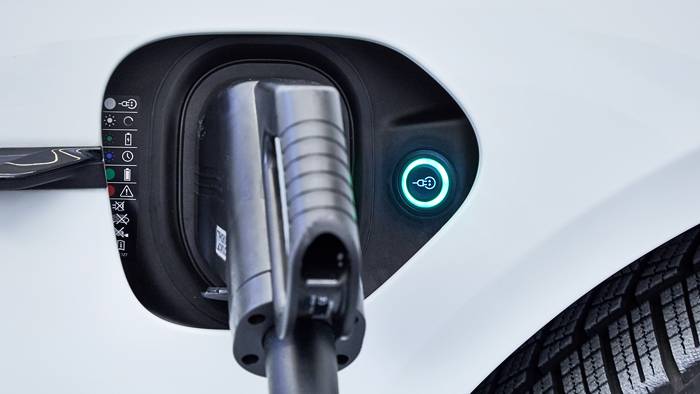
Looking for a freely configurable charging station for laboratory use?
Then the Smart Charging Station Emulator from dSPACE is for you.
Smart Charging Station Emulator
As a special configuration, the solution features a system that emulates the electrical and communicative behavior of a charging station. This makes it possible to simulate a freely configurable charging station in the laboratory. It complies with all international standards and is flexibly designed for voltages of up to 1,000 V. Furthermore, the Smart Charging Station Emulator can be equipped with multiple DC power supplies depending on the requirements, thus allowing for a charge rate of 85 kW both at the 400 V and 800 V level. In customer projects, the configuration can be expanded to include more power supplies and reach higher power levels. To test the AC charging process, the dSPACE real-time system offers diverse interfaces for controlling a grid emulator, which makes it possible to simulate the various network types in the target markets or phase distortions, for example.
Standardized Test Libraries
The standardization committees have thought about how to ensure interoperability between the charging station and the vehicle. Test libraries with hundreds of tests were created for this purpose. They provide a good basis but gene-rally are not sufficient for assessing all eventualities. Here, the dSPACE solutions stand out from the rest of the market with their ability to be integrated into any test. All tests are implemented as transparent test scripts to allow for a more in-depth interpretation of the results. The first conformance test is planned for summer 2021. The test libraries will be implemented by the engineering service provider KPIT. Customers can also benefit from KPIT’s extensive experience in executing tests.
Automatic Payments
Automatic payments usher in a new chapter in the field of electric charging. Similar to paying with a credit card, encryptions and certificates are used and it must be verified that they are exchanged correctly. dSPACE is working with a back-end provider on this to guarantee a seamless validation chain and quickly roll out solutions on the market. The goal is to support both component and integration testing and vehicle approvals.
Frontloading via Software Simulation
Of course, charging technology can also benefit from early validation by means of software-in-the-loop (SIL) testing. dSPACE tools have been used for years to test virtual ECUs, which are often developed according to the AUTOSAR standard. This test option is currently being tried out for smart charging, too, in order to validate communication and interaction with other software components at an early stage in the development process. As a result, it is possible to perform interoperability tests even without the electric vehicle communication controller (EVCC) hardware. This is especially advantageous since the earlier an error is detected, the easier it is to resolve it.
dSPACE MAGAZINE, PUBLISHED MAY 2021

